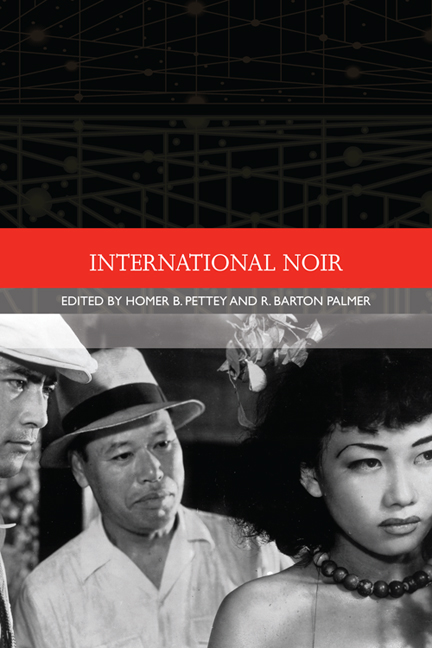Book contents
- Frontmatter
- Contents
- List of Illustrations
- Acknowledgements
- Notes on the Contributors
- Traditions in World Cinema
- Introduction: The Noir Impulse
- 1 British Noir
- 2 French Noir 1947–79: From Grunge-noir to Noir-hilism
- 3 French Neo-noir: An Aesthetic for the Policier
- 4 Early Japanese Noir
- 5 The Gunman and the Gun: Japanese Film Noir since the Late 1950s
- 6 Darker than Dark: Film Noir in its Asian Contexts
- 7 Nordic Noir and Neo-noir: The Human Criminal
- 8 Indian Film Noir
- 9 The New Sincerity of Neo-noir
- 10 Post-noir: Getting Back to Business
- Selected Bibliography of International Film Noir
- Selected Filmography of International Film Noir
- Index
5 - The Gunman and the Gun: Japanese Film Noir since the Late 1950s
Published online by Cambridge University Press: 05 August 2016
- Frontmatter
- Contents
- List of Illustrations
- Acknowledgements
- Notes on the Contributors
- Traditions in World Cinema
- Introduction: The Noir Impulse
- 1 British Noir
- 2 French Noir 1947–79: From Grunge-noir to Noir-hilism
- 3 French Neo-noir: An Aesthetic for the Policier
- 4 Early Japanese Noir
- 5 The Gunman and the Gun: Japanese Film Noir since the Late 1950s
- 6 Darker than Dark: Film Noir in its Asian Contexts
- 7 Nordic Noir and Neo-noir: The Human Criminal
- 8 Indian Film Noir
- 9 The New Sincerity of Neo-noir
- 10 Post-noir: Getting Back to Business
- Selected Bibliography of International Film Noir
- Selected Filmography of International Film Noir
- Index
Summary
‘Nikkatsu Noir’ – there is something very provocative about this: the alliteration, the double consonants in ‘Nikkatsu’ and the invocation of ‘noir’, certainly the most evocative of all genre names. In packaging its Eclipse Series 17, for the first time Criterion – the estimable company that has revolutionised the field of DVD–Blu-ray distribution with its combination of scholarly subtance and first-rate transfers of usually non-mainstream movies – did not group the films by director. From Japan, Criterion had previously released ‘Late Ozu’, ‘Postwar Kurosawa’, ‘Silent Ozu’, ‘Kenji Mizoguchi's Fallen Women’ and ‘Travels with Hiroshi Shimizu’. But ‘Nikkatsu Noir’ was something different: not just the release of a group of little-known films, but a kind of invention of a genre. It would be churlish to claim that the films – I am Waiting (Ore wa matteiru ze, Kurahara Kureyoshi, 1957); Rusty Knife (Sabita knife, Masuda Toshio, 1958); Take Aim at the Police Van (Sono gosôsha wo nerae: ‘Jûsangô taihisen’ yori, Suzuki Seijun, 1960); Cruel Gun Story (Kenju zankoku monogatari, Furukawa Takumi, 1964); and A Colt is My Passport (Colt wa ore no passport, Nomura Takashi, 1967) – are not noir. That the films were not originally imagined as noir would not, of course, disqualify them from being noir. There was no imagination of ‘noir’ as such in classic Hollywood in the postwar era and no discourse of noir. There was a cycle of films with enough similarities to strike critics, first in France in 1955, as a kind of genre, movement or mode. Only when named and when this name entered more popular discourse did ‘noir’ take on the kind of generic cachet it has today. While noir had little cachet in the late 1950s for the Japanese, by the turn of the new century it certainly would.
After listing many of his influences, Joe Shishido (Shishido Jo) is asked if film noir is one of his influences on Rusty Knife and films of that era. He answers with a brief, ‘Yes, that was an influence, on everyone from the director to the actors. I was the one who knew that genre best’. Maybe so, but what did he know and when did he know it? Noir classics like Out of the Past, The Lady from Shanghai and In a Lonely Place had not played in Japan.
- Type
- Chapter
- Information
- International Noir , pp. 112 - 135Publisher: Edinburgh University PressPrint publication year: 2014



